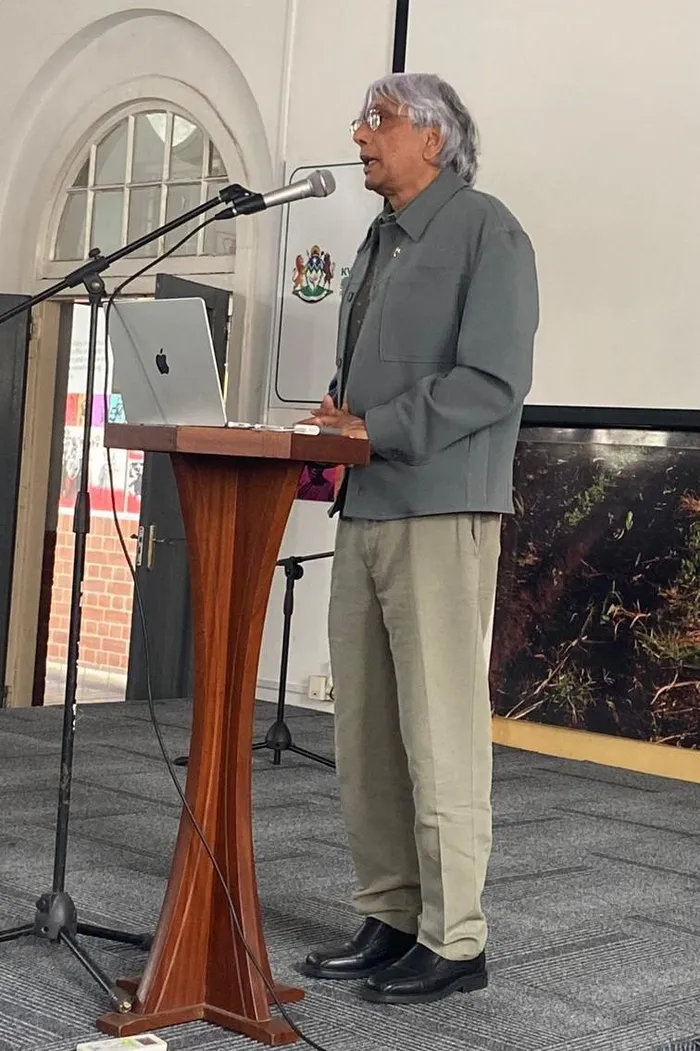Exploring the history of indentured workers

University of Cape Town Emeritus Professor Rajend Mesthrie at the 1860 Heritage Centre.
Image: Supplied
Tomorrow, South Africa observes a significant milestone as it marks the 165th anniversary of the arrival of the first Indian indentured workers aboard the SS Truro in 1860.
This historic event has been commemorated through various activities, including a public lecture hosted today by the 1860 Heritage Centre in KwaZulu-Natal, which is under the auspices of the Department of Sports, Arts and Culture.
Emeritus Professor Rajend Mesthrie, a prominent linguist and scholar, delivered an enlightening lecture titled “The Durban Ships’ Lists of Indenture: A socio-geographic reanalysis of the districts of origin”.
He analysed the Durban ship lists of Indenture from 1860 to 1911.
Mesthrie, who is best described as a linguist, said his work continues the tradition of historians who have worked on the Indian communities of South Africa, on indenture and the plantations.
Among those that he mentioned were A.G. Choonoo in the 1960s, Joy Brain and Suresh Bhana in the 1980s and beyond, and present-day historians like his wife Uma Dhupelia-Mesthrie, Goolam Vahed and Ashwin Desai, among others.
Having completed his PhD on Bhojpuri-Hindi, the primary North Indian language brought to South Africa, that evolved on the plantations of KwaZulu-Natal.
"This work earned the trust of historians who sometimes consulted me on matters of language, names and placenames. Joy Brain, the primary historian of indenture, before her passing sent a gift to Uma and me of a CD containing the full list of each line of the ships lists captured by her and her small team on Excel.
"This was a massive amount of valuable systematic information which she had spent a lifetime compiling. Her hope must have been that some of us would take it further by doing detailed analyses of the patterns therein," said Mesthrie.
Mesthrie, who was a Professor of Linguistics at UCT, said during the Covid-19 pandemic and with free time having retired from lecturing, he decided to analyse the lists for the total information on the districts of India from which each and every indentured worker came from.
"This has always been an interest of mine, one which has linguistic ramifications for us specialists. I thought it would take two years to do. But the sheer detail of working with over 150 000 lines of information took over double that time.
"Because of Covid I couldn’t assemble a team of statisticians or data analysts, but worked with a single part-time undergraduate assistant. We did basic extraction and collation via Excel, broke the details of the districts into 10 year periods and now have a complete, accessible and digestible account of the states within India and the districts within them that produced the people of indentured origins in South Africa," he said.
He added that the study will therefore pertain mainly to those considered of Tamil, Telugu, Hindi and Urdu origins.
Mesthrie said as already known, one of the key findings from the research is that the majority of people, 46.7%, came from what is now Tamil Nadu state.
"While ordinary people believe their roots are in Madras, this is not the case. The majority of workers came from a neighbouring district called North Arcot. This is the district that is of greatest relevance to KwaZulu-Natal.
"Another important finding for South Indians is that the number of Telugu incoming workers was larger than made out in previous surveys, whose projections stopped short of the full five year analysis I did. Among the Telugu speakers, the district of Visakhapatnam had the most. Andhra Pradesh added another 16% or so to the Tamil total from South India. Turning to the north of India, although Calcutta was the port of origin and an important part of migrants identity, the number who came to Natal from Calcutta or indeed the Bengal area was negligible. The majority came from districts of what is now Uttar Pradesh and secondly Bihar," he said.
Mesthrie added that there were more migrants from Rajasthan and Orissa than what was realised; and that there were Gujaratis and Maharashtrians among the indentured too, but in very small numbers.
Last year Mesthrie co-edited a book with a colleague from India, Sonal Kulkarni-Joshi of Deccan College, Pune called “Language in the Indian Diaspora”.
Working on Indian languages and indentured history covers about a third of Mesthrie's research.
"I am equally pleased to work on African languages and English as an international language."
Related Topics: